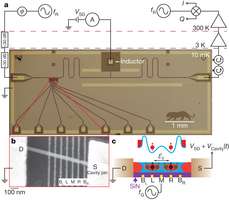October 18, 2012 report
Researchers determine spin rate of qubit by measuring microwave field inside superconducting circuit

(Phys.org)—Researchers at Princeton University have demonstrated that coupling spin qubits may be feasible over long distances by measuring the microwave field inside of a superconducting circuit to determine the spin rate of a single electron quantum bit (qubit). Their work, as they explain in their paper published in the journal Nature, may be a first step towards creating a true quantum computer.
Most scientists agree that in order to carry out the kind of logic operations needed for scaled up quantum computing, a means of moving information from more than just a single qubit must be found. To date, such transfers have been made to happen between neighboring electrons on the order of nanometers – quantum computers of the future will require transfers on the millimeter scale. To achieve such a scale, the team at Princeton suggest the concept of a "quantum bus" as a means of providing a pathway for communications between more than one spin based qubit.
To use a qubit in logic operations its spin rate is observed to be in either an up "1" or down position "0" state. In order for such information to be useful, a means must be used to control the spin state. In this new research the team used microwave signals. By creating a microwave field around the qubit, the researchers were able to change and read its spin state and by extending the concept to create a superconducting circuit that included more than one qubit, they were able to create a quantum bus that allows for the transfer of information between more than one qubit.
Coupling distant qubits has been done before using superconducting qubits – the results have lasted for too short of a time however to be usable in a quantum machine. In this new research, the coherence time, as it's known, has been greatly increased using the quantum bus they created – long enough to allow for large scale quantum computing. The hope is that the idea can be expanded to include the coupling of many more qubits all separated by the large distances involved in constructing an actual quantum computing device.
More information: Circuit quantum electrodynamics with a spin qubit, Nature 490, 380–383 (18 October 2012) doi:10.1038/nature11559
Abstract
Electron spins trapped in quantum dots have been proposed as basic building blocks of a future quantum processor. Although fast, 180-picosecond, two-quantum-bit (two-qubit) operations can be realized using nearest-neighbour exchange coupling4, a scalable, spin-based quantum computing architecture will almost certainly require long-range qubit interactions. Circuit quantum electrodynamics (cQED) allows spatially separated superconducting qubits to interact via a superconducting microwave cavity that acts as a 'quantum bus', making possible two-qubit entanglement and the implementation of simple quantum algorithms. Here we combine the cQED architecture with spin qubits by coupling an indium arsenide nanowire double quantum dot to a superconducting cavity. The architecture allows us to achieve a charge–cavity coupling rate of about 30 megahertz, consistent with coupling rates obtained in gallium arsenide quantum dots10. Furthermore, the strong spin–orbit interaction of indium arsenide allows us to drive spin rotations electrically with a local gate electrode, and the charge–cavity interaction provides a measurement of the resulting spin dynamics. Our results demonstrate how the cQED architecture can be used as a sensitive probe of single-spin physics and that a spin–cavity coupling rate of about one megahertz is feasible, presenting the possibility of long-range spin coupling via superconducting microwave cavities.
Journal information: Nature
© 2012 Phys.org



















